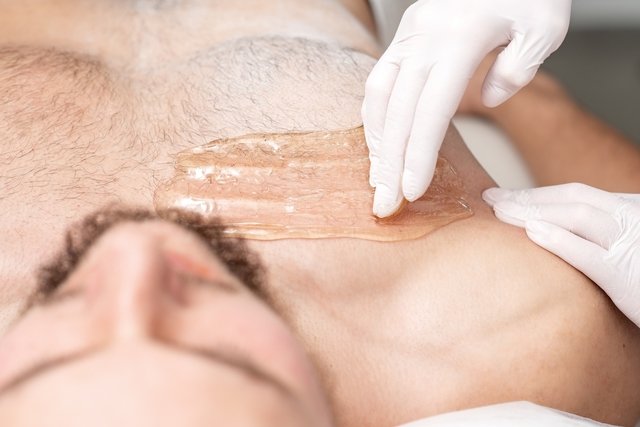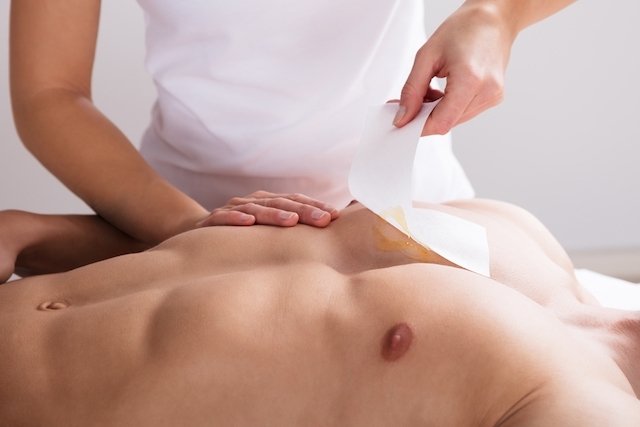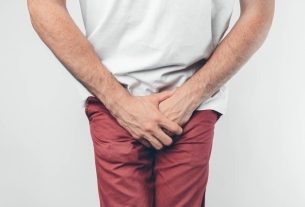In most cases, male hair removal is done just for aesthetic reasons, especially in areas such as the chest, back, stomach and legs. However, waxing can also be a good way to control perspiration and, therefore, many men may choose to wax when they suffer from hyperhidrosis, in the armpits, for example, a condition where there is an exaggerated production of sweat.
There are several hair removal techniques, such as waxing, depilatory creams, lasers, razors and even epilator machines, with each technique having its advantages and disadvantages, depending on how long the hair removal is expected to last, for example, and the location to be waxed.
It is important that before and after waxing the skin is maintained hydrated and that before waxing, the man makes adequate preparation according to the technique to be performed.

How to make
Male hair removal can be done using more than one technique, depending on the location where the hair removal will be done:
1. Cera
Waxing promotes the complete removal of hair from the root, so that the effect of waxing lasts longer and can last for 2 to 4 weeks. When waxing is done regularly, hair may take longer to grow.
This type of hair removal can be used on the chest, stomach, back, arms and legs, but can also be used carefully on the face.
How it is done: When waxing, a thin layer of melted wax must be applied to the area, which cools while it sticks to all the hair. Then, this layer is quickly removed so that the hair is completely removed.
There is also the option of hair removal with cold wax, in which small strips of wax are used and can be purchased at the pharmacy or supermarket. See how to properly wax with hot or cold wax.
To guarantee a better result with the wax, you should trim your hair with a shaver before applying the wax, as well as take a bath in warm water, to open the pores and remove any type of cream you may have on your body. as it can make it difficult for the wax to stick to the body.
Disadvantages: It is a painful method that can cause skin irritation and should not be used in more sensitive areas, such as the intimate area.
2. Depilatory cream
Hair removal with depilatory cream is easy to perform and does not cause any discomfort, as it does not cause the hair to be removed from the root. Depilatory cream works like a chemical razor, as it contains a set of substances that make the hair thinner and destroy its base, causing it to fall out in a few minutes.
Depilatory cream is generally recommended for hair removal on the chest, stomach, back, arms and legs and, therefore, should not be used in the intimate area.
How it is done: To shave with depilatory cream, you must apply a layer of cream to the area and leave it on for 5 to 10 minutes, according to the instructions on the packaging. Then, remove the cream along with the hair using a small spatula. After removing the hair, wash the skin with warm water and a neutral pH soap.
There are different types of depilatory creams, especially for normal or sensitive skin, so the ideal is to choose a cream and apply it to a small area, before using it on a large area of the body, to see if any type of irritation appears.
Disadvantages: because they do not remove the hair at the root, they have a shorter effect and, therefore, the hair can appear again in 1 to 2 weeks. Additionally, if left on the skin for longer than indicated on the packaging, it may cause skin irritation.
3. Blade
Shaving is one of the oldest techniques for removing hair and is therefore also frequently used. However, with this method there is a greater risk of cuts to the skin, which can result in infections, for example.
Most of the time, the razor is recommended for those who have little hair, or when you want to shave more sensitive areas, such as the intimate area, as it allows you to regulate the intensity of the hair removal, as long as it is done carefully and gently.
How it is done: In the case of shaving, you must apply a cream suitable for shaving, such as shaving creams, for example, but you can also use soap. It is important to avoid shaving on dry skin, as there is greater friction, increasing the risk of cuts, skin irritation and ingrown hairs. See everything you need to know to shave.
Disadvantages: there is a greater risk of cuts to the skin and ingrown hairs, as the hair is not removed from the root, nor is it weakened as with depilatory cream.
4. Laser hair removal
Laser hair removal is a good option for hair removal and can even result in permanent hair removal, as the root of the hair is removed. Laser hair removal can be done on any part of the body, including the groin.
How it is done: In laser hair removal, a type of laser is used, which can be diode or alexandrite, which shoots a large amount of energy into the hair, in order to destroy the root, eliminating the hair and reducing the chances of it growing back.
This type of hair removal can cause some pain and, therefore, should always be done in clinics specializing in laser hair removal to avoid complications such as skin burns or even wounds. Normally, it is necessary to do between 4 and 6 sessions for the hair to stop growing in a certain region, but this can vary from man to man, according to skin color, for example.
Disadvantages: It is common for the skin to become a little irritated and sensitive after laser hair removal, so it is recommended to apply plenty of moisturizer, exfoliate the area regularly and avoid exposing the area to the sun.
5. Epilator machine
The epilator, also known as an electric epilator, is a small device that removes hair from the root, working in a similar way to waxing. Normally, this type of device can be used on dry or wet skin and, therefore, can be used while taking a shower, for example.
Hair removal with an epilator can be recommended for the belly, chest, back, arms and legs.
How it is done: Before shaving with an epilator, it is recommended to trim the hair with a shaver before using the electric epilator, as long hair can make it difficult for the device to work. Although these machines can be used while showering, waxing is generally easier on dry skin, as the hair is less stuck to the skin and is more easily grabbed by the epilator.
Disadvantages: causes some discomfort when pulling hair from the skin and can leave the skin irritated.
How to do intimate waxing
Since the intimate region is an extremely sensitive area, the ideal is to just trim the hair, using scissors or a shaver, for example. However, if you want to completely remove hair and leave your skin smooth, one of the best options is to shave.
When shaving with a razor, you must be very careful to avoid cutting the skin, especially in the scrotum and anal region. Creams, although they can be easily applied to this area, can cause a lot of irritation, even when they are suitable for sensitive skin and, therefore, should also be avoided.
Wax can be used to remove hair from the groin or pubic area, however it is not recommended for use in more sensitive areas. Furthermore, many men have also resorted to permanent hair removal, such as laser, to reduce hair in the region and facilitate hygiene, however, this method is much more painful and is limited only to the groin area as well. See more details about laser hair removal.
Hair removal care
To ensure a better waxing result and avoid problems, such as irritated skin or ingrown hairs, there are some precautions that you should always take before and after waxing, which include:
- A few days before waxing, trim your hair using a shaver;
- Exfoliate your skin 2 to 3 days before waxing;
- Take a bath with warm water to remove any type of cream or product from the skin and open the pores;
- Maintain adequate skin hydration by applying moisturizer every day.
- Avoid going out in the sun or staying in the sun for a long time after the procedure;
- Avoid swimming in pools or entering jacuzzis, due to the presence of chlorine, which can make the skin more irritated after waxing;
In addition, approximately 2 to 3 days after waxing, it is also recommended to exfoliate the skin to remove the remains of hair and dead cells. This exfoliation can be gentle and can be done up to the first 10 days after waxing.

Sign up for our newsletter and stay up to date with exclusive news
that can transform your routine!
Warning: Undefined array key "title" in /home/storelat/public_html/wp-content/plugins/link-whisper-premium/templates/frontend/related-posts.php on line 12
Warning: Undefined array key "title_tag" in /home/storelat/public_html/wp-content/plugins/link-whisper-premium/templates/frontend/related-posts.php on line 13




